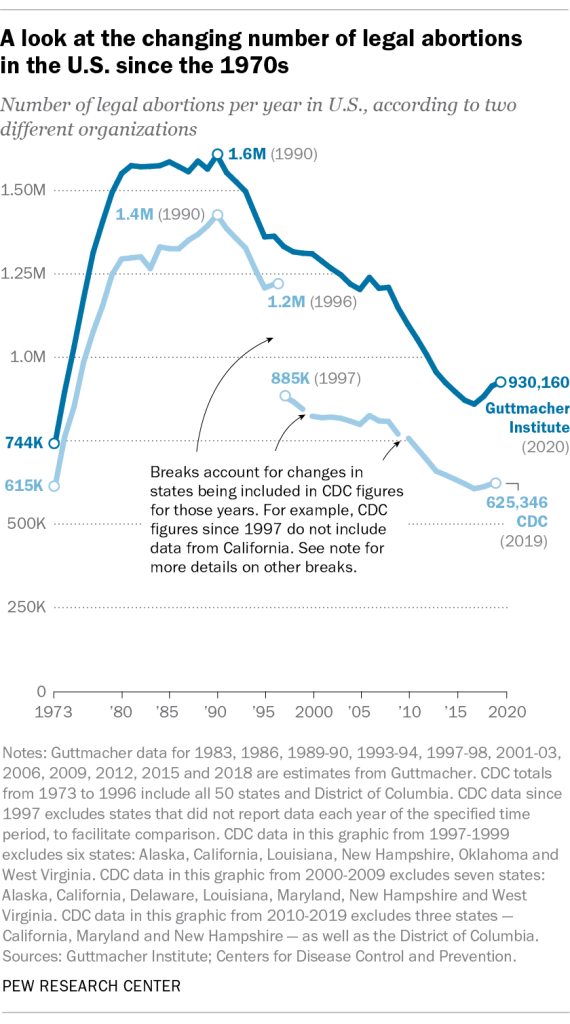Why, Who’s going to pay for all of these babies? should be more like, What are these babies going to pay for in the future?
Put on your tin foil hats and prepare to reference Elon Musk’s Twitter feed for this one. 🚀
In June of 2022, the Supreme Court reversed Roe v. Wade, the 1973 ruling that made access to abortion a constitutional right. Overturning Roe v. Wade has some obvious, pretty immediate implications for women in America.
Media on both sides of the aisle have been hyper-focused on the individual, whether that be the woman with an ectopic pregnancy whose life is at risk or the baby having life taken away before it starts.
These emotional messages appeal to us, yours truly included. But, they upstage big, long-term trends at play, a little bit like missing the forest for the trees.
This post outlines the long-term trends that banning abortion could help change, like underpopulation. I’m not suggesting that reacting to these trends is the primary motive behind banning abortion, but having more babies could have broad economic impacts.
It goes a little something like this:
- Tax revenue is driven by economic growth.
- Economic growth is driven by population growth.
- Population growth comes from births and immigration.
- Births come from Millennial and Gen Z women. 🤰🏽
There are ~3.6 million babies born each year in America. Those little nuggets are the future growth engine of our country. Access to abortion holds that number back.
In fact, research by the Guttmacher Institute says that there were over 930,000 abortions nationwide in 2020, which is about a quarter of the total births that took place.
To be fair, an abortion ban across all 50 states is not on the table. It is a real consideration, however, in over half.
Immediately following the reversal of Roe, abortion was banned in 13 trigger states. As a result, Caitlin Myers, a professor of economics at Middlebury college, estimates that 75,000 women who are unable to obtain an abortion will give birth this coming year.
Problem 1: America’s Aging (and Expensive) Population
The 65+ club is one of the fastest growing demographics in the country. 2020’s census reported that about 17% of the total 331 million Americans were considered elderly. (Sixty-five is the age at which one is considered elderly by the government. I don’t make the rules, Karen!)
For comparison, only 4% of the population was elderly in 1900. By 2040, it will have jumped to 80.8 million, or 22% of the population.
There are two major factors contributing to this retiree mosh pit.
- Boomers, who comprise 21% of the U.S. population (second in size only to Millennials), are reaching retirement age. By 2029, the youngest vintage of this generation will be 65+.
- Older Americans are getting even older. So, not only is the sheer number of Americans over 65 ballooning, but the composition of those folks is older. Compare the following stats from 2019 to 1900 as an extreme example. In 2019, there were 53 times more 85-plus-year olds than there were in 1900.
Source: The Administration for Community Living
| Age | 2019 Population | 1900 Population | Multiplier |
| 65 to 74 | 31,500,000 | 2,190,000 | 14x |
| 75 to 84 | 16,000,000 | 771,000 | 20x |
| 85+ | 6,600,000 | 122,000 | 53x |
These later years of life are super expensive for social programs, primarily because of medical costs. For those fortunate enough to make it to the ripe old age of 85, you should expect to incur a third of your lifetime medical expenses in your remaining years.
Problem 2: Chronic Low Birth Rates = Future Underpopulation Crisis
The birth rate in the United States has been steadily declining since the Great Recession. During the three decades preceding 2007, it held roughly steady at 65-70 births per 1,000 women between ages 15 to 44.
As of 2020, the birth rate had declined to 56 births per 1,000 women, a new record low for the U.S. Further, the number of babies that a theoretical group of 1,000 women would have over their lifetimes fell to just 1,638.
This is below the replacement rate of 2,100 babies per 1,000 women. The replacement rate of 2.1 is the ratio of children required to replace both parents over the long haul, keeping the population stable.
Researchers and economists aren’t sure why birth rates have been falling. The high cost of raising kids, better job prospects for women, high student debt, and more effective birth control have all been posited. My personal anecdotes support all of these theories, but none actually checked out when researchers analyzed large swaths of data.
Abortion isn’t necessarily the cause of birth rates falling, either, but it certainly isn’t helping. Perpetuating this period in which fewer babies are born puts the U.S. at risk of underpopulation. That would put a big damper on the future economic prospects of the country.
Problem 3: Long-Run Economic Growth Needs a Boost
Long-run economic growth is fueled, in part, by growth of the labor force. Little Liam might be preoccupied with sticking his finger in an outlet right now, but in 20 years, he’ll become a productive, tax-paying member of society.
The equation for economic growth is actually really simple. Real GDP Growth = Productivity Growth + Population Growth.
The population growth part of the equation comes from one of two sources: immigration and births. The Congressional Budget Office expects the labor force to grow by 0.5% per year. A third of that will be driven by births. The other two thirds should be driven by immigration.
Productivity growth, the other piece, is also projected to be about 0.5% per year. That tallies to a whopping 1% expected real GDP growth produced by the U.S. economy over the long haul.
Consequences of population growth aside, you can see why the government could have an incentive to take reproductive decision-making out of the hands of American women. By removing the option to abort a pregnancy, it increases the chances that actual population growth shakes out higher than was expected.
And, as highlighted in the Open Yale Courses podcast on Global Problems of Population Growth (with Professor Emeritus of Molecular, Cellular & Developmental Biology, Robert Wyman, Ph.D.), population growth becomes inherently more difficult to project when women have greater control over reproduction.
The more choices women have, the more difficult it is for the Census Bureau to even try to accurately estimate the birth component of population growth.
Problem 4: Solve for Solvency of Social Security
You’ve probably at least heard of Social Security before, even if it was only through a complaint that Millennials and Zoomers will never see a dime of it. Social Security provides retirement benefits to American workers over the age of 65.
The Social Security Administration (SSA) has made very large, public commitments to retired Americans. During our working years, 12.4% of every paycheck (half paid by you, half paid by your employer) goes to the SSA in the form of a tax. Then, in our 60s, we become eligible to receive benefits.
Social Security is a pay-as-you-go system, meaning that current inflows pay for the vast majority of current benefits due out to retirees. This exchange between taxpayers and retirees is over $1 trillion each year. In essence, it cash-flows payments due out with revenue from payroll taxes.
The pay-as-you-go system is only possible with a younger workforce. In the future, policymakers will need to solve for a shortfall. In its current state, only 75% of promised benefits can will be paid out by year 2035 because America’s population is skewing so much older. That’s not a good look.
The SSA’s website flat-out says that the increasing costs of our aging population can’t be met because birth rates dropped from three to two children per woman.
Why You Should Care
Millennial and Gen Z women will bear the costs today of improving the trajectory of economic trends in America. Sure, the government could take a more supportive approach to incentivizing families to have more children, but not without adding public expense to an already stressed budget.
In the book Valuing Children by Nancy Folbre, she estimated that roughly two thirds of annual spending to raise a child is borne by the family. This seems like a pretty good investment for our boy, Uncle Sam.
When sharing this draft with my husband, he remarked that I was giving politicians too much credit for their foresight. He might be right 🤗, but sooner rather than later, these financial problems of tomorrow will become problems of today.
When it’s time to find solutions for them, policymakers just got one more tool in their belts: banning abortion. Leveraging this tool comes at the emotional, physical, and financial expense of young American women.
The opinions voiced in this material are for general information only and are not intended to provide specific advice or recommendations for any individual. To determine which investments may be appropriate for you, consult with your financial advisor.


